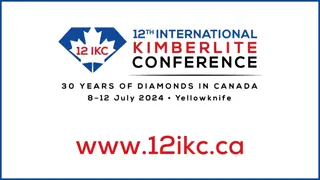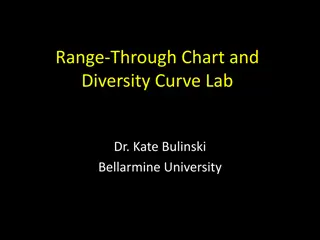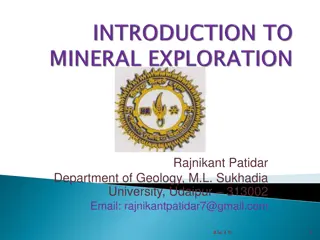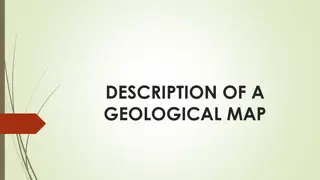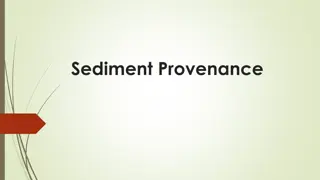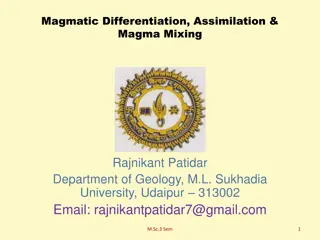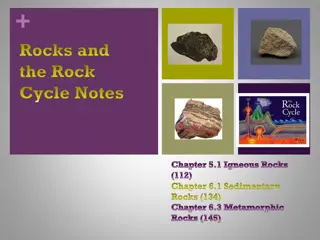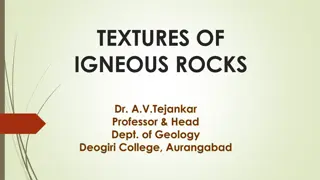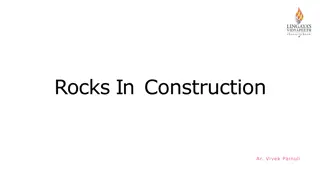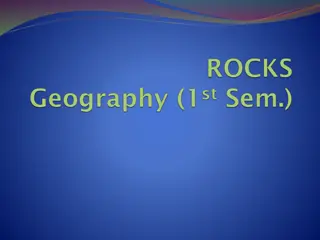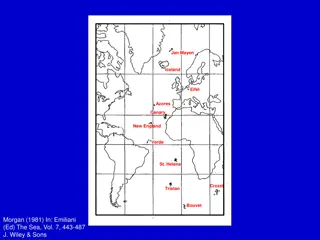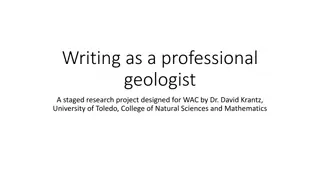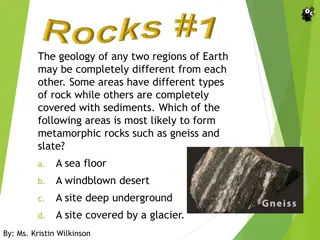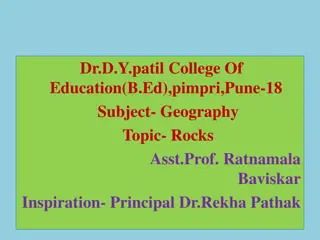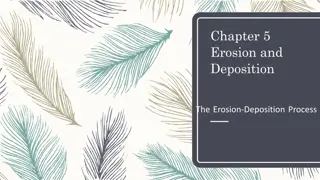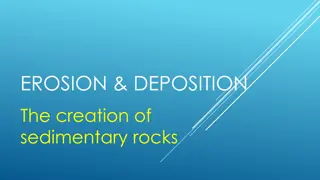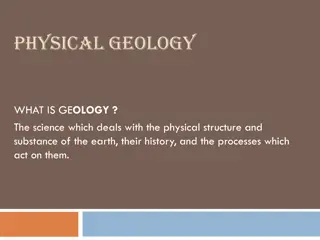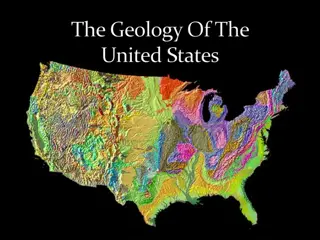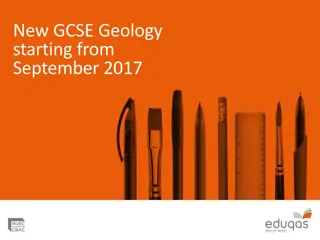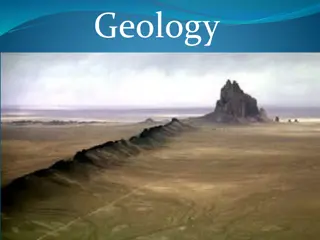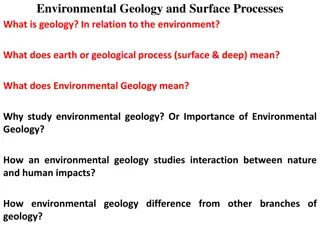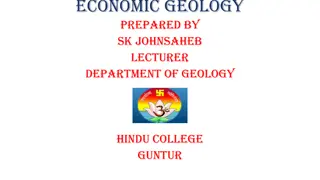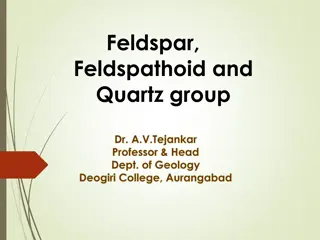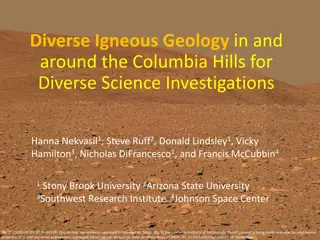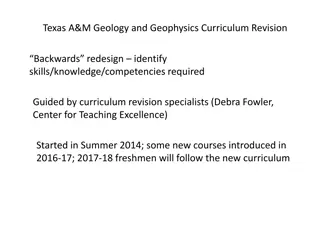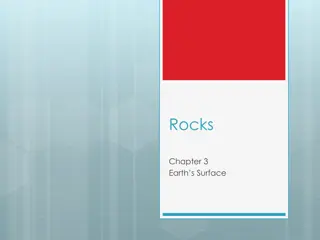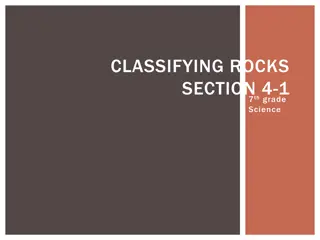Geology of Ogun State, Nigeria: Insights and Implications
The geology of Ogun State in southwestern Nigeria, particularly within the Dahomey or Benin Basin, holds significant value for understanding the region's origins and geological evolution. This includes insights on sedimentary basins, the Wilson Cycle, and the unique characteristics of the Dahomey or
3 views • 35 slides
Engineering Geology for a Habitable Earth: Presentation at XIV IAGEE Congress
Presenting at the XIV Congress of the International Association for Engineering Geology and the Environment on the topic of Engineering Geology for a Habitable Earth. The presentation covers the background of the project, methodology used, results obtained, and conclusions/recommendations drawn. Tip
7 views • 8 slides
Insights from the International Kimberlite Conference on Diamonds and Geology
Delve into the world of diamond mining and geology with a focus on Kimberlites. Explore topics such as diamond deposits exploration, mantle petrology, and economic geology presented by experts in the field. Discover the origins and evolution of Kimberlites, advancements in prospecting techniques, an
6 views • 8 slides
Geology Unit Review
This geology unit review covers identifying different processes such as uplift, subduction, and convection, as well as types of volcanoes like cinder cones and composite volcanoes. It also discusses the Pacific Plate and its unique characteristics, along with volcanic activity around the Ring of Fir
2 views • 9 slides
Medical Geology and Environmental Health Studies at Western Oregon University
Explore the interdisciplinary field of Medical Geology at Western Oregon University, covering topics such as environmental exposure, geological impacts on nutrition, geologic hazards, and water quality. Discover how the Earth's subsystems interact and affect human health, with a focus on pathways of
1 views • 12 slides
Understanding Fossil Diversity in Geology Labs
Explore the world of fossils and geological time scales in a Geology for Non-Science Majors lab under Dr. Kate Bulinski at Bellarmine University. Understand major paleontological events, diversifications, mass extinctions, and groups of organisms while learning to graph in Microsoft Excel.
0 views • 21 slides
Understanding Minerals, Rocks, and Ores in Geology Studies
Exploring the world of geology, this content delves into minerals as inorganic substances with specific compositions, rock formations of various origins, and ore classifications encompassing metallic, noble, industrial, gemstone, and fuel resources. It covers the definitions, characteristics, and cl
0 views • 19 slides
Understanding Geological Maps: Interpretation and Description
Training in geological map interpretation aims to accurately identify features depicted on maps through careful examination of geological information. The description of a geological map involves a chronological synthesis of geological data, analysis of the geology of an area focusing on relief, suc
0 views • 15 slides
Understanding Sediment Provenance in Geology
Sediment provenance in geology involves reconstructing the origin of sediments through compositional analyses to determine erosion history and geographical origins. It helps characterize the journey of sediments from source to sink, providing insights into tectonic and paleoclimatic histories. Prove
2 views • 11 slides
Understanding Magmatic Differentiation and Magma Mixing
Magmatic differentiation is the process through which a single homogeneous magma can produce diverse rock types by generating fractions of different compositions. This variation in igneous rocks results from mechanisms like fractional crystallization, liquid immiscibility, vapor transport, and diffu
1 views • 29 slides
Understanding the Rock Cycle: Igneous, Sedimentary, and Metamorphic Rocks
This educational material covers the formation and characteristics of Igneous, Sedimentary, and Metamorphic rocks. It includes details on the processes involved, such as heat melting rocks into magma, sediment formation through erosion and deposition, and the differentiation between intrusive and ex
1 views • 16 slides
Insights into the Siwaliks: Geography, Geology, and Climate
Siwaliks, part of the Himalayan range, hold a rich geological history with unique landscapes and diverse flora and fauna. Stretching from Bhutan to Pakistan, these mountains boast a variety of rock layers, surrounding rivers, and distinct climates. The region's straitigraphy and geology mark it as a
1 views • 34 slides
Understanding Textures of Igneous Rocks in Geology
Structures associated with igneous rocks are primary features that contribute to their strength, distinguish rock groups, and reveal origin. Textures, like crystalline patterns, indicate cooling and crystallization processes. Different cooling rates lead to varied textures such as holocrystalline, h
0 views • 16 slides
Understanding Resistivity Measurements in Geology
Explore the concept of resistivity measurements in geology, focusing on electrode configurations such as Wenner and Schlumberger arrays. Learn about the potential differences in electrode setups and how to calculate apparent resistivity through geometrical factors. Various electrode arrangements and
0 views • 22 slides
Understanding Earth's Geology: Chapter 6 Clicker Questions
Chapter 6 of the Earth's geology covers various topics including the melting associated with the addition of carbon dioxide or water to rocks, types of magma based on silica content, descriptions of hot mafic magma, and characteristics of pyroclastic flows in volcanoes. Test your knowledge with thes
0 views • 11 slides
Importance of Rocks in Construction and Building Materials
Rocks play a crucial role in construction as geological materials for foundations and building structures. They are classified into igneous, sedimentary, and metamorphic categories based on their composition and properties. Traditional stone masonry is being replaced by modern techniques like stone
1 views • 15 slides
Understanding Different Types of Rocks and How They Form
Rocks are essential components of Earth's crust, consisting of various minerals held together by natural cement. They can be categorized into three groups: Igneous, Sedimentary, and Metamorphic rocks. Each group is formed differently, either through volcanic activity, sedimentation, or existing rock
3 views • 16 slides
Understanding Rocks and Minerals: Types and Formation
Rocks and minerals are natural substances with distinct characteristics. Rocks are solid aggregates of minerals or mineraloids, while minerals are naturally occurring chemical compounds. There are three main types of rocks: igneous, sedimentary, and metamorphic, each formed through different process
0 views • 16 slides
Evolution of Igneous Activity in Various Hotspot Areas Over Millions of Years
Detailed historical account of igneous activity in hotspot regions such as Iceland, Eifel, Azores, and Canary Islands from Morgan's study. The progression of volcanic events over different geologic periods is illustrated through images and descriptions. The timeline ranges from 200 Ma to present fin
0 views • 13 slides
Professional Geologist Research Project in Geology Courses
Staged research project for WAC by Dr. David Krantz at the University of Toledo, focusing on sedimentology and stratigraphy in geology courses. Includes WAC approaches, self-reflection tasks, and writing exercises related to stratigraphy and the environmental sciences. Examples and writing tasks lik
0 views • 18 slides
Understanding Earth's Geology and Rock Formation
Earth's geology varies across regions, with distinct rock types like metamorphic rocks found in particular environments. Learn about the characteristics of rocks, the properties of different rock types, and the impact of human activities on the rock cycle.
0 views • 7 slides
Understanding Rocks: Types, Formation, and Importance in Geology
Rocks are solid accumulations of minerals found in the Earth's lithosphere. They are classified into igneous, sedimentary, and metamorphic types based on their mineral composition. Rocks play a crucial role as geological materials for construction and historical buildings. Learn about the properties
0 views • 31 slides
Geology Test Review: Rocks and Minerals
This review covers the identification of rocks as igneous, sedimentary, or metamorphic, along with definitions and properties of minerals like cleavage, crystal structure, streak color, and more. It also discusses the classification of rocks as foliated or nonfoliated. Prepare for your geology test
2 views • 112 slides
Understanding Erosion and Deposition Processes in Geology
Explore the dynamic forces of erosion and deposition in geology, from the constructive and destructive processes to weathering, erosion agents, rates of erosion, sorting of sediment, deposition, and different depositional environments where sediments settle. Delve into how factors like weather, clim
0 views • 12 slides
Understanding Erosion, Deposition, Weathering, and Mass Movement in Geology
Explore the processes of erosion, deposition, weathering, and mass movement in geology. Learn about how rocks are broken down and carried away, the different types of weathering, and the factors affecting these processes. Discover the role of gravity in erosion and the impact of chemical reactions o
0 views • 18 slides
Evolution of Geoscience Education at Rutgers University
The Rutgers Geology Museum played a significant role in the development of geoscience education in the 19th and 20th centuries at Rutgers University. From the rise of geology in the United States to the establishment of geology courses at the university, key figures like George H. Cook and A.H. Ches
0 views • 12 slides
Formation of Finger Lakes Geology
Explore the geology and formation of the Finger Lakes region as detailed in the USGS Professional Paper 1089 by Fullerton (1980). Learn about the intriguing processes that shaped these unique lakes and their surrounding landscapes. Stunning images depict the geological features and illustrate how th
0 views • 6 slides
Understanding the Goldschmidt System in Geology
Explore the Goldschmidt System in geology, which classifies chemical elements based on their preferred host phases. Learn about lithophile elements concentrated in the Earth's crust and the elemental composition of the crust. Discover the significance of chondrites in meteorites and the foundational
0 views • 11 slides
Exploring Careers in Geology: Opportunities and Pathways
Geology is the scientific study of the Earth's physical structure, substances, history, and processes. This field offers diverse career opportunities, from teaching and economic geology to environmental and engineering geology. Geologists play crucial roles in understanding natural hazards, explorin
0 views • 13 slides
The Geology of the United States: Overview of Major Provinces and Landforms
The geology of the United States is diverse and fascinating, organized into 10 key geologic provinces along with Hawaii and Alaska. Orogeny processes have shaped the land over time, adding new land to the Precambrian craton. Geologic maps depict the location and age of rocks in the uppermost crust u
0 views • 45 slides
New GCSE Geology Overview and Assessment Details
Explore the new GCSE Geology starting from September 2017, introduced under the Eduqas brand. The course offers a comprehensive examination structure with components including Geological Principles assessments involving multiple-choice and structured writing questions. Contact details for subject of
0 views • 30 slides
Exploring the Fascinating World of Geology and Earth Sciences
Delve into the diverse field of geology, covering topics such as physical and historical geology, geochronology, mineralogy, petrology, and more. Learn about the solar nebula hypothesis and the Earth's lithosphere, hydrosphere, atmosphere, and biosphere. Discover the composition of Earth's atmospher
0 views • 12 slides
Understanding Environmental Geology and Surface Processes
Geology in relation to the environment involves studying Earth's geological processes, both surface and deep, and their impacts on nature and human activities. Environmental geology focuses on the interaction between humans and the Earth's near-surface environment, addressing hazards like erosion, f
0 views • 71 slides
Understanding Economic Geology: A Comprehensive Overview
Economic geology, as discussed in the provided content, delves into the commercial and industrial utilization of Earth's resources. Covering topics such as mineral deposits, ores, gangue minerals, common economic minerals, and classification of mineral deposits, this field plays a crucial role in id
0 views • 33 slides
Basic Principles of Medical Geology and Trace Elements Overview
This session delves into the fundamental principles of medical geology and its impact on human health. It explores how exposure to certain elements in the geologic environment can affect well-being, emphasizing pathways of trace elements into the body and their consequences. Dr. Patrick Asamoah Saky
0 views • 26 slides
Understanding Pyroxene Group in Geology: Composition and Significance
Pyroxenes are vital rock-forming minerals found in various types of igneous rocks and metamorphic conditions. They consist of linked SiO4 tetrahedra, forming structural chains with specific chemical compositions. The orthorhombic and monoclinic pyroxenes play essential roles in geology, demonstratin
0 views • 15 slides
Exploring Diverse Igneous Geology in and around the Columbia Hills
Studying the diverse igneous geology in and around the Columbia Hills provides insights into Martian atmosphere, volatile budget, age, source characteristics, cooling history, and more. Researchers have uncovered valuable information by coupling unaltered igneous rocks with meteorites and surface sp
0 views • 19 slides
Texas A&M Geology & Geophysics Curriculum Revision and Development
Involving a backward redesign led by curriculum revision specialists, the Texas A&M Geology and Geophysics curriculum has been undergoing changes since 2014. The revision aims to identify the necessary skills, knowledge, and competencies for students. It includes new courses introduced in 2016-17, w
0 views • 5 slides
Understanding Rocks and the Rock Cycle
Explore the world of rocks through this educational content on Earth's surface, rock cycle, rock types (igneous, sedimentary, metamorphic), and the formation of igneous rocks from magma and lava. Learn how rocks are made of minerals, the continuous process of the rock cycle, and the classification o
0 views • 29 slides
Understanding Rock Classification in 7th Grade Science
When studying rocks, scientists analyze their mineral composition, color, and texture. Rock-forming minerals play a significant role in Earth's geology, with granite and basalt being prime examples. The texture of rocks is determined by the size, shape, and pattern of grains present. Rocks form thro
0 views • 9 slides


